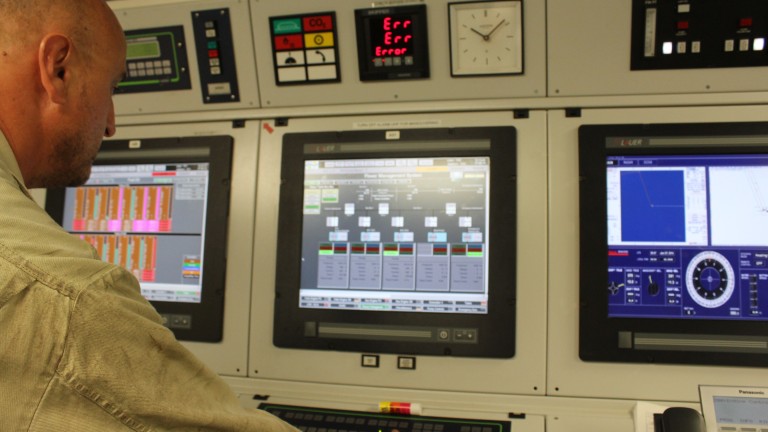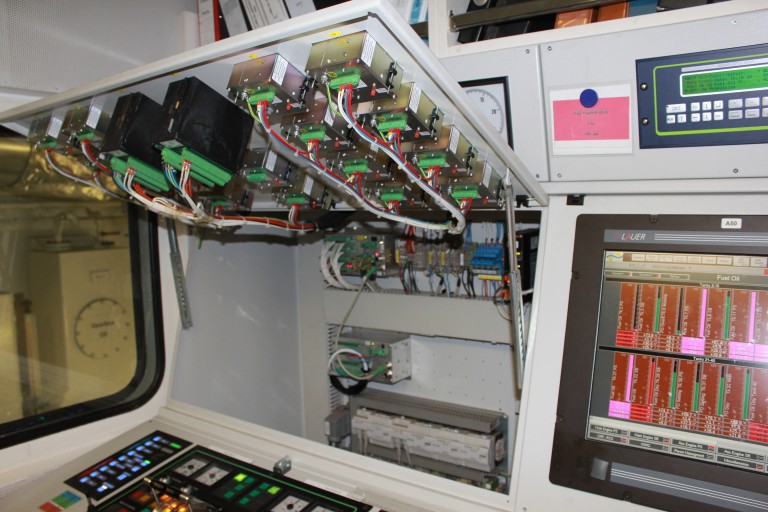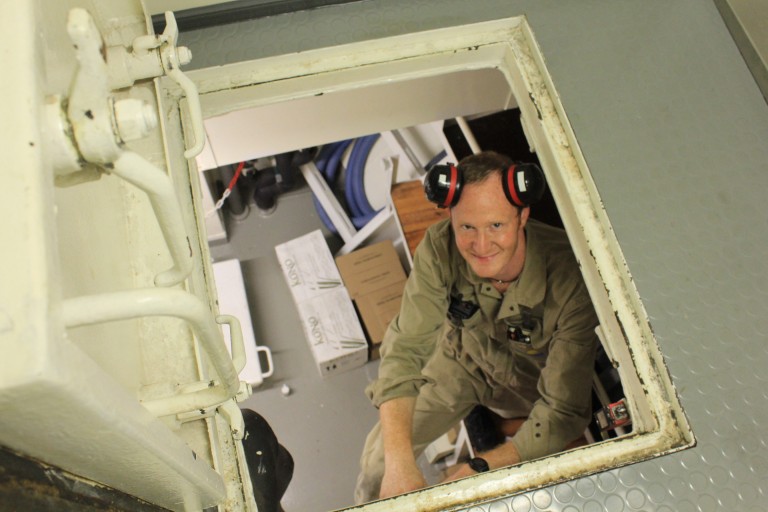
Most of the time when you tour a ship you see the main areas where the science gets done, the aft deck, wet lab, control room, but have you ever thought about what powers all these amazing technologies? I didn’t until recently, when I was graciously offered a tour of the engine room, also known as “the heart” of R/VFalkor. I thought it important to share this critical part of the ship, where many of the engineers work hard to keep Falkor running efficiently.
Touring the engine room
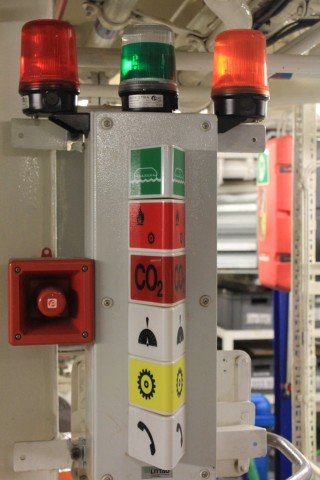
Falkor engineer Dan Buhler, guides us through a corridor taking me behind the scenes into a large room with brightly colored pipes and machines, moving parts, and warm temperatures. Dan advises me to put in a pair of ear plugs to help muffle the loud sounds of the engines; safety always comes first. Since this area is louder than most parts of the ship, it has its own alarm system so that engineers working can be notified of any problems. The alert panel has special signals for things like a general alarm, fire, a carbon dioxide extinguishing system, an alert from the bridge to change speeds, an alert to a change in the engine systems, or something as simple as a phone call.
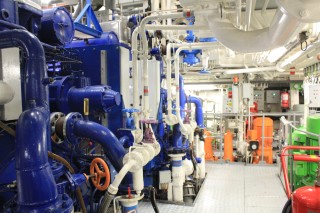
Dan explains that the engine rooms needs to be kept organized and clear at all times, in case a problem occurs. For this reason, they color coordinate the pipes and main pieces of equipment: red for emergency systems, green for ballast or sea water, orange for oil pumps, purple for compressed air, blue for the generators and engine, you get the idea.
Powering the ship
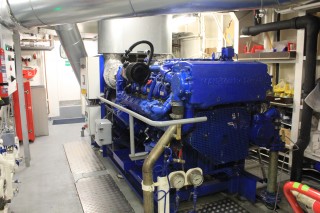
Our first stop is the science generator also known as “generator number three”, this is what distributes power to most of the science equipment like the computers in the control room, the multibeam mapping equipment, and the CTD Rosette. There are four generators in total, but having a generator for the science equipment itself ensures that there is a stable flow of power to reliably complete ongoing science operations. The other sources of power include the emergency generator (don’t be fooled by its name, this generator is not just for emergencies), and another generator that can be driven from two sides. On one side is the auxiliary engine, and on the other side is the main engine that gives energy to the ship’s propeller, that’s why we call it the main engine – more on that later.
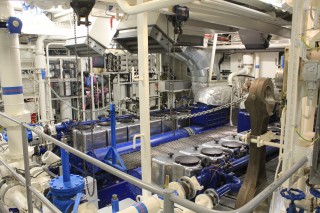
Shuffling forward we arrive at the main engines, these are common internal combustion engines like the ones you would find in your car, just a lot bigger! They are critical to the success of the ship, without them we could not driveFalkor. Taking a closer look at the engine, Dan points out the gear box, and individual working parts of the engine. Did you know that these engines start with compressed air?

Walking by the network of fuel pipes, we pass the pressure gauges or meters that show the pressure for different areas like the auxiliary (which changes the pitch of the boat with the propellers) or hub pressure. Again, these pressure gauges or monitors are similar to the ones you would find in your car except a lot better. If your car’s oil pressure is low, the maintenance light would go on and you would take your car to the mechanic. The same rules apply to the ship, except these gauges will not only sound an alarm if pressure gets too low, but will automatically stop certain parts if there is something wrong with the oil pressure. These are just a few of the dozens of pressure gauges on board. They are critical to telling you how the ship is running.
Water is essential
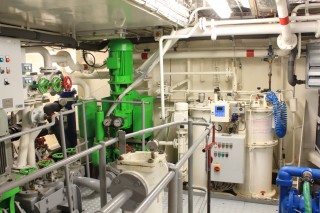
Water is another very important component of the engine room. First on our water-related ship parts is the oily water separator, this helps to keep the bilge water (dirty water from the ship) from mixing with other water sources or expelling dirty water into the ocean. The green metal container to the left of the water separator is the piston pump that can be used for ballast pumping or putting out fires; however, the ship has a designated firefighting pump so basically this area gets ignored. The other green container is the sea chest or water inlet valve that brings in water to cool the engine systems down. Continuing on the theme of water, we see a hot water boiler that is used to do the opposite of the sea chest, yes you guessed it, to pre-heat the ship engines.
While exploring the water systems, we stumble upon electro technical officer Todor Gerasimov working on a fresh water flow sensor. When you are out at sea far from land, you have to rely on the engineers to be able to fix problems with what’s on board, that is why it is important to have a well stoked workshop, and excellent crew of course!
Fuel and steering
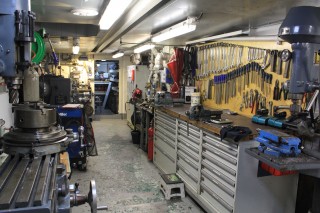
Moving along on the tour, we enter a smaller room called the “purifying room”. No, this is not where you come to detox, but more importantly where the ship oils get cleaned. Lube oil can sometimes get dirty with soot from the combustion process or pick up particles left over in the pipes, so after it is stowed the oil runs through this purifier. The other critical liquid to the ship is fuel for the engines to run on. When Falkor goes out to sea it can be gone for over a month and will need to bring fuel for that entire time. The majority of the fuel gets stored in several tanks at the bottom of the ship, and will get transferred in small amounts to the “day tank” where the fuel is then ready for use.
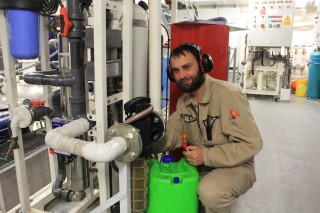
We hurry along past the purifiers and arrive at the beating heart ofFalkor, the connecting rod that moves back and forth between the ships two rudders. We can move the ship and change directions with just one rudder, but having two makes Falkor more maneuverable. Next to the connecting rod is the actual steering gear, which is also important for motion. Dan shows me the tunnel for the thruster, which is used to turn the ship by pushing water to the port (left) or starboard (right) side on the ship during maneuvering.
Boat control to Major Miro
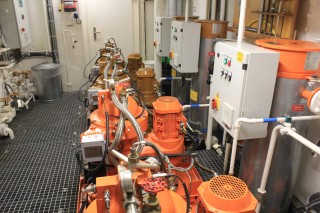
Last stop on our tour is the brain, the engine control room. Chief engineer, Miro Mirchev explains how he monitors and controls the engines and ship’s power with the bright colored buttons and screens on the main panel. Miro points to the three screens showing the ships fuel oil levels (far left), power management system (middle) and the captain’s screen (far right). Here, Miro can control the main engine for pitch and speed, which gets coordinated with the captain and all the officer on the bridge. Lastly, Miro lifts the panels and shows all the inner workings of the console.
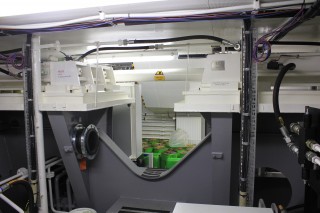
After spending some time walking through the engine room and learning about the inner workings of Falkor, I have a new appreciation for the heart of this ship, and for the hard working engineers like Miro, Todor, and Dan.
